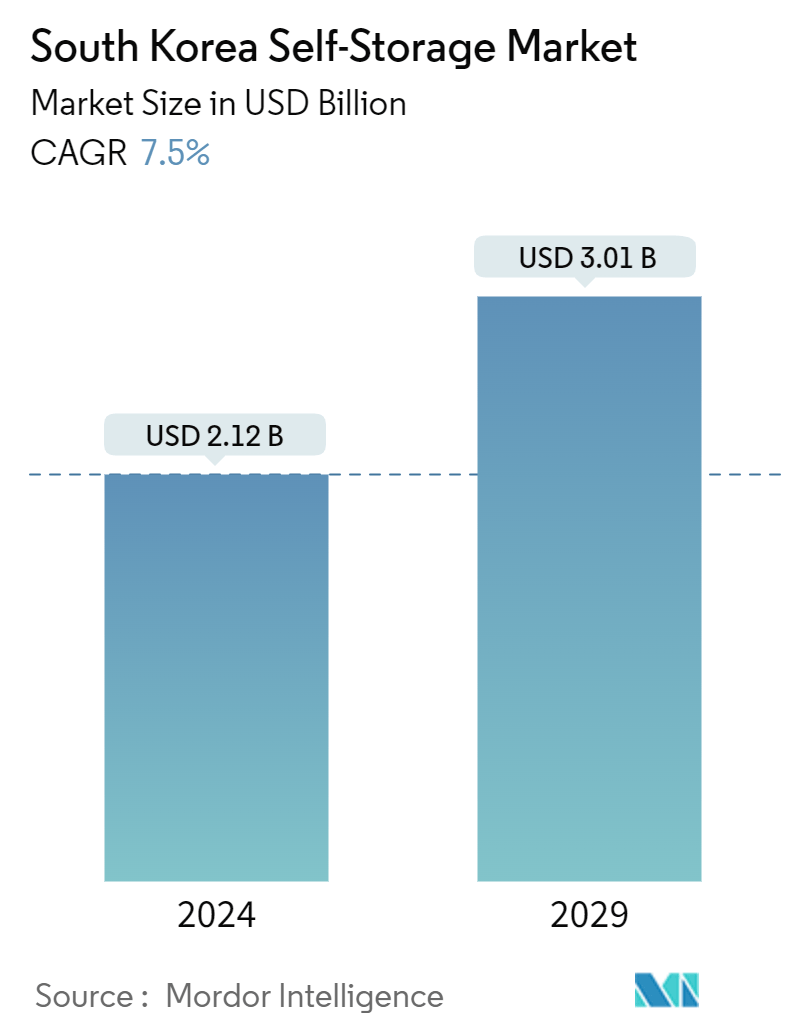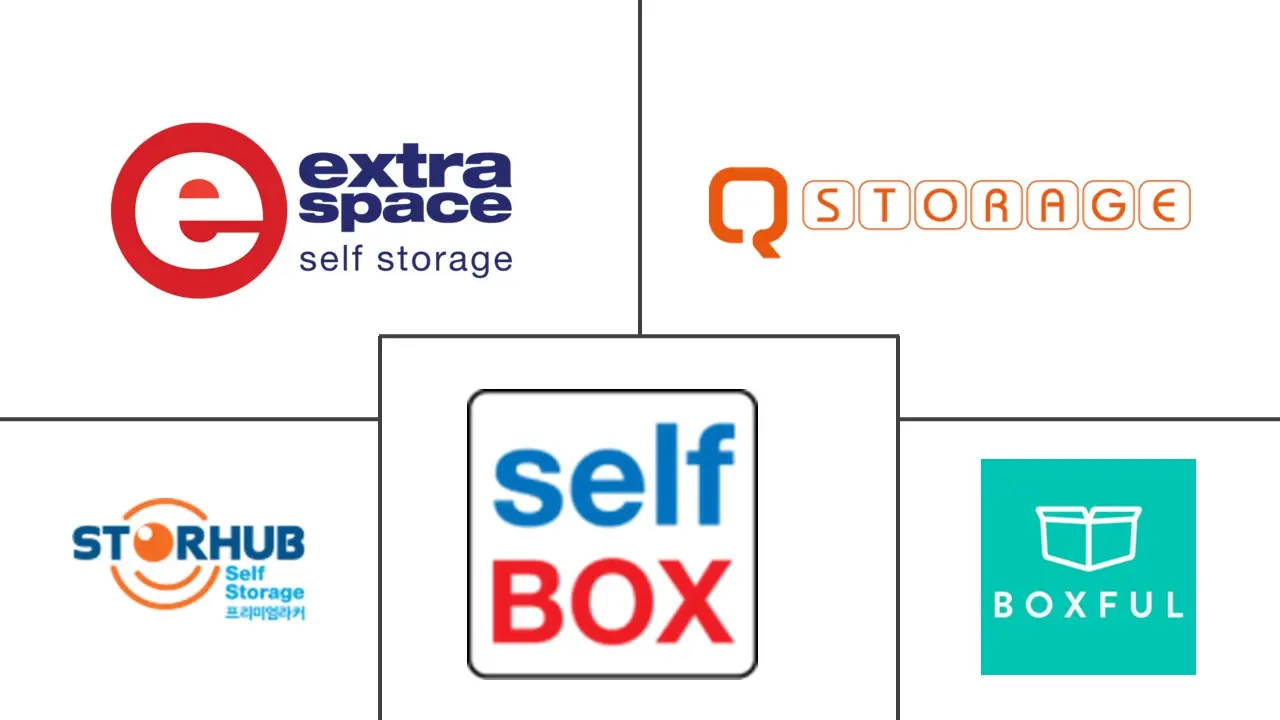Market Size of South Korea Self-Storage Industry

| Study Period | 2019 - 2029 |
| Base Year For Estimation | 2023 |
| Market Size (2024) | USD 2.12 Billion |
| Market Size (2029) | USD 3.01 Billion |
| CAGR (2024 - 2029) | 7.50 % |
| Market Concentration | Low |
Major Players
*Disclaimer: Major Players sorted in no particular order |
South Korea Self-Storage Market Analysis
The South Korea Self-Storage Market size is estimated at USD 2.12 billion in 2024, and is expected to reach USD 3.01 billion by 2029, growing at a CAGR of 7.5% during the forecast period (2024-2029).
- Urbanization Driving Demand for Self-Storage Solutions: South Korea's rapid urbanization is a key driver of the self-storage market. Over the past two decades, the urban population has increased by around 7 million, with 81% of the population now residing in cities. This shift has led to smaller living spaces, spurring demand for storage solutions.
- Population Density and Property Market Growth: Population density in South Korea reached 515 people per square kilometer in 2021, with Seoul having the highest density at 16,000 per square kilometer. This urban crowding, combined with a strong real estate sector that contributed KRW 138.36 trillion to the GDP in 2021, underscores the need for self-storage solutions.
- Property Price Concerns: A Gallup Korea study revealed that 57% of respondents expect property prices to continue rising, further squeezing living spaces and driving the demand for self-storage facilities.
- Flexible Work Arrangements Reshaping Storage Needs: The rise of remote and hybrid work in South Korea has created a new dynamic in the self-storage market. The shift has introduced storage needs for both individuals and businesses as workspaces are reorganized.
- Remote Work Surge: By August 2021, over 3.5 million workers in South Korea were using flexible work arrangements, a significant increase from 2.9 million in 2020. This shift has increased the need for decluttering home offices, fueling demand for self-storage solutions.
- Business Storage Requirements: Decluttering home offices and business spaces, along with the need to store infrequently used office equipment, is driving self-storage demand among employees adapting to flexible work models.
- Business Restructuring Boosting Self-Storage Demand: South Korea's changing business landscape, partly driven by global supply chain disruptions, is creating new demand for self-storage facilities.
- Reshoring and Downsizing: A 2022 survey by the Federation of Korean Industries found that 27.8% of major South Korean corporations were considering relocating their overseas operations back to South Korea, up from 3% in 2020. Meanwhile, 33.3% of small business owners in a 2021 survey reported considering the suspension of operations, contributing to the need for temporary storage solutions.
- Inventory Storage: Business closures and downsizing have led to a surge in demand for storage of inventory, furniture, and equipment in self-storage units.
- Evolving Self-Storage Market Characteristics: The South Korean self-storage market continues to evolve, with facilities adapting to meet diverse customer requirements and embracing technological advancements.
- Variety in Storage Sizes: Self-storage units offer a wide range of options, from 36,000 cm³ to 30,240,000 cm³, catering to different storage needs. Pricing models depend on factors like box quantity, locker size, and additional features such as hangers or containers.
- Technological Shifts: The market is shifting towards unattended, automated facilities similar to laundromats, with online reservations and virtual tours becoming increasingly popular for customer convenience.
- Market Structure and Growth Potential: The self-storage market in South Korea is expected to maintain steady growth, with a mix of leased and owned properties shaping its development.
- Facility Growth: By 2023, the number of self-storage facilities in South Korea is expected to reach 226, covering a lettable area of 513,246 sq. ft. Leased properties accounted for a larger share of the market compared to owned properties in 2021, though new entrants are increasingly interested in owning spaces.
- Building Conversions: The majority of new self-storage construction comes from building conversions, offering faster launch times than ground-up developments, helping to address space constraints in urban areas.
- Location and Technology Driving Market Dynamics: The success of self-storage facilities in South Korea is closely linked to their locations and the adoption of technology.
- Urban Center Focus: Small-scale storage facilities, especially in urban centers, prioritize accessibility via public transportation, catering to individual customers who need easily reachable storage solutions.
- Technological Integration: South Korea's technological strength enables innovative solutions such as easy online reservations, virtual unit selection, and automated services, making the storage process more efficient.
South Korea Self-Storage Industry Segmentation
Self-storage is an industry that rents storage space, such as rooms, locker rooms, containers, and outdoor space, also known as "storage units," to tenants, usually on a short-term basis. Self-storage is available for individuals and small and medium-sized businesses in flexible, shorter, or longer periods and thes storage facilities are highly professional and different from empty warehouses or attics.
The South Korea self-storage market is segmented by end-user (personal, business).The market sizes and forecasts are provided in terms of value (USD) for all the above segments.
| By End-user | |
| Personal | |
| Business |
South Korea Self-Storage Market Size Summary
The South Korea self-storage market is experiencing robust growth, driven by urbanization, shrinking living spaces, and the increasing need for decluttering homes and offices. As cities become more densely populated and average home sizes decrease, self-storage facilities are emerging as a practical and cost-effective solution for both personal and business needs. The market is characterized by a steady expansion of storage facilities, offering consumers improved convenience and accessibility. Technological advancements are further enhancing the appeal of self-storage, with features like online reservations and automated, unattended facilities becoming more common. The COVID-19 pandemic has accelerated this trend, as remote work and rising housing costs have prompted more individuals and businesses to seek additional storage options.
The market landscape in South Korea is moderately fragmented, with several global players competing through competitive pricing, promotional activities, and value-added services such as climate-controlled storage and 24/7 access. The presence of these players, along with the entry of new ventures backed by venture capital, is intensifying competition and driving innovation in the market. Despite the challenges posed by the pandemic, such as reduced tourism and its impact on storage demand, the market continues to grow, supported by the ongoing need for space management in urban areas. The self-storage industry is poised for further expansion, catering to the diverse needs of South Korean consumers and businesses alike.
South Korea Self-Storage Market Size - Table of Contents
-
1. MARKET INSIGHTS
-
1.1 Market Overview
-
1.2 Industry Attractiveness - Porter's Five Forces Analysis
-
1.2.1 Threat of New Entrants
-
1.2.2 Bargaining Power of Consumers
-
1.2.3 Bargaining Power of Suppliers
-
1.2.4 Threat of Substitute Products
-
1.2.5 Intensity of Competitive Rivalry
-
-
1.3 Industry Value Chain Analysis
-
1.4 Impact of COVID-19 on the Market
-
-
2. MARKET SEGMENTATION
-
2.1 By End-user
-
2.1.1 Personal
-
2.1.2 Business
-
-
South Korea Self-Storage Market Size FAQs
How big is the South Korea Self-Storage Market?
The South Korea Self-Storage Market size is expected to reach USD 2.12 billion in 2024 and grow at a CAGR of 7.5% to reach USD 3.01 billion by 2029.
What is the current South Korea Self-Storage Market size?
In 2024, the South Korea Self-Storage Market size is expected to reach USD 2.12 billion.

